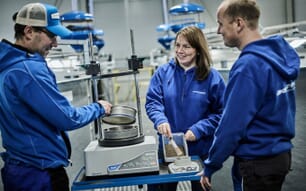1. What's in salmon feed?
A key aspect in the sustainability of salmon aquaculture is the amount of wild fishmeal and fish oil contained within our feed supplies. In 1990, the wild fish-derived component of feeds could be as high as 80 per cent.
Today, following extensive research into fish nutrition, commercial feeds for salmon can contain as little as 15 per cent fishmeal and 15 per cent fish oil. In other words, raw material of marine origin can be as low as 30 per cent, without negative effects on the health and growth of the salmon.
Vegetable instead of marine raw materials
Over a period of 20 years, salmon farmers have gradually substituted marine raw materials with vegetable raw materials, while sustaining the health benefits and quality of farmed salmon. This change in the dietary composition has reduced our dependency on forage fish considerably.
Since 2004, volumes of farmed Atlantic salmon have increased significantly in parallel with a significant reduction in utilised volumes of fishmeal and fish oil. Salmon is an excellent vehicle for omega-3 (fatty acids), an important component of human nutrition.
However, the amount of these healthy components in the fish is to a large degree mirrored by the level of fish oil in the feed. Fish oil is the main source of omega-3 in feed and, in the future, the level of fish oil substitution will mainly be determined by the market requirement for omega-3 in salmon.
2. How much forage fish is used for 1 kg of salmon?
Some people believe we need 3, 5, 7 or even 10 kg of wild forage fish to produce one kg of farmed salmon. This is not correct.
Such assumptions and calculations are based on our dependency on fish oil, not our use of wild fish. That is a big difference.
Fish oil is a by-product from the production of fishmeal. Before we started salmon farming, this fish oil was used mainly for technical purposes like fuel and hardening of fat. We believe it is better to use fish oil for fish farming.
So how much do we actually use?
To produce 1 kg of salmon, we need around 180 g of fish oil. To extract 180 g of fish oil, we need 2.5 kg1) of forage fish. From these 2.5 kg, we also get approximately 560 g of fishmeal, of which 180 g goes into the fish feed.
To put it simply: From 2.5 kg of forage fish, of which as much as 90 per cent may not be directly usable as human food, you get 1 kg of healthy and nutritious salmon. In addition to this, you get a surplus of around 380 g of fishmeal, which goes into the production of more seafood.2)
In comparison, wild salmon needs to eat 10 kg of wild fish to grow 1 kg.
You can dig deeper into the calculations of the usage of forage fish here.
- 2.5 kg is the reference figure for the Norwegian salmon farming industry, representing about 70 per cent of the global production of Atlantic salmon.
- In 2008, 33 per cent of the fishmeal produced in the EU and 25 per cent globally, came from trimmings and offal from the fish food processing industry. This represents a further reduction of the amount of wild forage fish used to produce 1 kg of salmon, as presented above, but has not been included.
3. Efficient food production
Salmon farming is among the most efficient ways of producing protein-rich food.
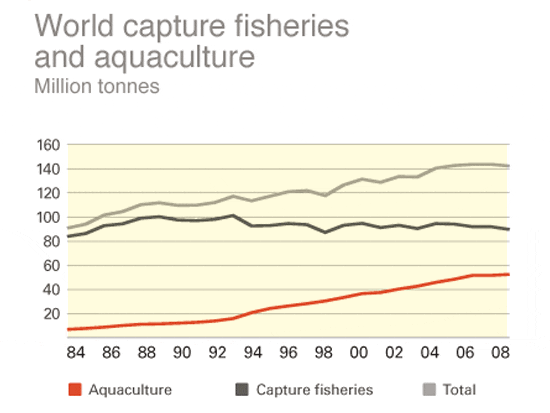
Feed conversion ratio (FCR) is a helpful way of describing efficiency in terms of how much feed is required to produce 1 kg of fish. For salmon, the FCR is around 1.2. This means that to produce 1 kg of salmon, you need around 1.2 kg of feed. Although not directly comparable, due to differences in the composition and energy density of the feed, other food industries such as poultry, pig, sheep and cattle farming have feed conversion ratios of around two, three, eight and eight respectively.
The low feed conversion ratio of salmon farming is explained partly by the following factors:
- Salmon feed has a high energy content and is highly digestible
- Salmon are very efficient at utilising the protein in the feed and much more so than farmed animals. The protein retention, which is a measure of protein utilisation, can be as high as 45 per cent in salmon, while corresponding figures for poultry and pig are 18 and 13 per cent respectively. The high protein retention gives salmon farming an ecological advantage compared to production of other meats, as more of the proteins in the feed are converted into meat
- As salmon live suspended in water, they use very little energy to support themselves compared to land animals
- Salmon also need less energy to maintain bodily functions as their body temperature is always close to the ambient temperature, normally between 6 and 16 degrees Celsius
4. More farmed salmon using less wild fish as feed
Salmon farming has grown from a few thousand tonnes in the early 1970s to around 1,300,000 tonnes in 2010.
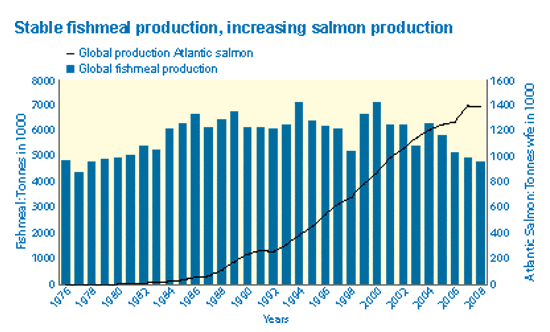
During the same period, the global production of fishmeal has been stable, and hence also the global catch of forage fish. It has been a clear ambition for the salmon industry to reduce our dependency on marine raw materials for feed. Since 2004, salmon farmers have actually reduced the use of fish meal and fish oil, and at the same time increased the production of salmon. We now produce more salmon than before, with less marine raw materials.
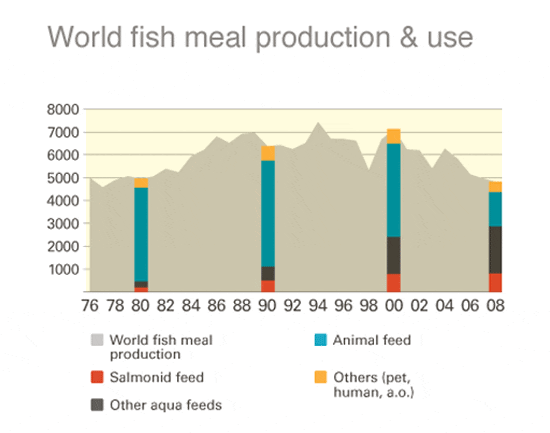
There can be large year-to-year variations in the global production of fishmeal and fish oil. However, the range of variations has been more or less the same for the last 40 years. For instance, fishmeal production was around 5 million tonnes in 1976 and at a similar level in 2008. In peak years, it can be as high as 7 million tonnes. There has also been a change in the utilisation of fishmeal, from animal feed to feeds for salmonids and aquaculture.
5. From fuel to healthy seafood
Before salmon farmers and other aquaculture farmers started using fish oil in their feeds, the fish oil was used for technical purposes.
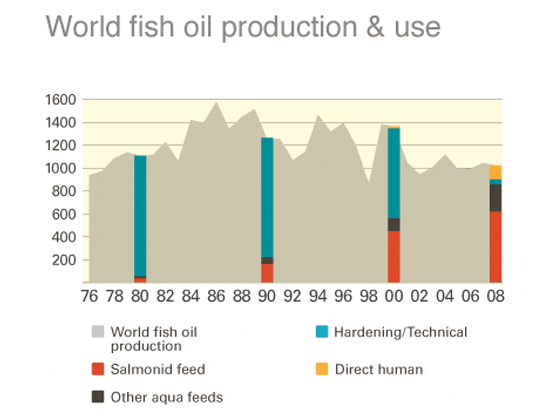
One of the ingredients in salmon feed is fish oil. Fish oil is a by-product from the production of fishmeal. The oil is squeezed out of the fish to produce meal.
With the rise in aquaculture, the use of fish oil has changed from industrial purposes to the production of seafood, rich on protein and omega-3, like salmon. Historically, fish oil has been used for hardening of margarine (thereby destroying all the healthy omega-3 fatty acids), fuel and other technical purposes, like paint.
We believe it is better to use this important resource for food production.
6. CO2 emissions: producing salmon vs other meats
Salmon farming is an energy-efficient way of producing meat, particularly when compared to the farming of land-based animals.
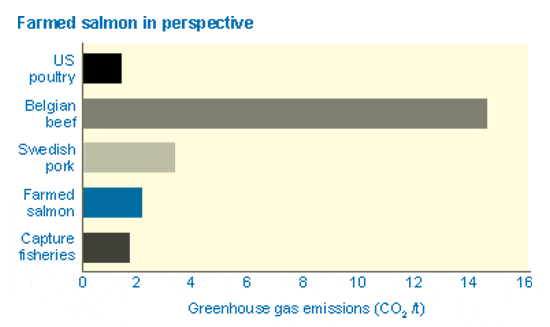
Nonetheless, we are working across our business using a life cycle assessment approach to become more energy efficient. This will not only cut costs but reduce the environmental footprint of the part of our operations which relies on energy from non-renewable sources that emit carbon dioxide.
More environmental benefits
The salmon industry has always sought to find the lowest possible input of feed resources. The use of high-energy-extruded diets means that less feed is used, and therefore less raw materials, to produce one kg of salmon. Reducing the amount of feed also means less use of transportation and thereby reduced CO2 emissions.
In addition, due to the excellent physical quality and high digestibility of extruded diets, there is less waste from production such as broken feed pellets and faecal material. This again reduces the discharge of phosphorous and nitrogen from farms.

